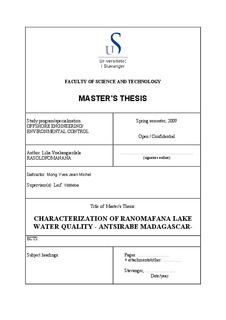| dc.contributor.author | Rasolofomanana, Lilia Voahangiarilala | |
| dc.date.accessioned | 2009-11-23T13:08:13Z | |
| dc.date.issued | 2009 | |
| dc.identifier.uri | http://hdl.handle.net/11250/182408 | |
| dc.description | Master's thesis in Environmental technology | en |
| dc.description.abstract | Analyses of water quality parameters in Ranomafana Lake showed that the lake is
hypereutrophic. It receives untreated wastewater from Antsirabe municipality by three
main inlets: the North West inlet, the North inlet and the North East inlet. And the
measured values in different stations indicate that, horizontally, the water is not well
mixed; peak values are recorded at station 3 located downstream the North West inlet.
For all measured parameters, daily variation was noticed. The surface water
registered a temperature difference of 2°C from morning to afternoon. The water pH was
slightly alkaline and ranged from 7.17 to 8.12 in the surface and from 7.1 to 7.95 in the
bottom. The dissolved oxygen in the morning was between 6mg/l to 12 mg/l in the surface
layer and between 4 mg/l to 8 mg/l at the bottom water. This amount increased from
morning to the afternoon due to the photosynthesis. Regarding the nutrient level, the total
nitrogen concentration in the lake water varied from 7.6 mg/l to 10.6 mg/l in February;
from 6.6 mg/ to 10.8 mg/l in March and from 6.3 mg/l to 12.1 mg/l in April. The total
phosphorus concentration ranged from 0.94 mg/l to 2.23 mg/l in February; from
0.99mg/l to 2.23 mg/l in March and from 0.94 mg/l to 3.85 mg/l in April. The quantity
was always higher in the afternoon. Ranomafana Lake water also had high chlorophyll a
concentration: 106 mg/m3 to 232 mg/m3 in February, 88 mg/m3 to 142 mg/m3 in March
and 131 mg/m3 to 238 mg/m3 in April.
Despite its hypereutrophic state, Ranomafana Lake water does not experience
oxygen depletion. The whole water column is aerobic due to high photosynthesis. The
main problems are high phosphorus concentration and algae concentration. They
contribute the most to the increase of water turbidity and to the decrease of Secchi disk
depth in this Lake. It is then necessary to reduce the nutrient level and the chlorophyll a
concentration in order to remediate the water quality. And for that purpose, our
recommendations consist of reducing the nutrient loads by treating the wastewater prior
to their discharge into the lake, increasing the nutrient uptake from the lake water by
promoting algae growth and then removing the excess of algae to clarify the water. | en |
| dc.format.extent | 1618104 bytes | |
| dc.format.mimetype | application/pdf | |
| dc.language.iso | eng | en |
| dc.publisher | University of Stavanger, Norway | en |
| dc.relation.ispartofseries | Masteroppgave/UIS-TN-IMN/2009 | en |
| dc.subject | offshore teknologi | en |
| dc.subject | teknisk miljøvern | en |
| dc.subject | water quality analysis | |
| dc.subject | lake monitoring | |
| dc.title | Characterization of ranomafana lake water quality - antsirabe madagascar | en |
| dc.type | Master thesis | en |
| dc.subject.nsi | VDP::Technology: 500::Environmental engineering: 610 | en |
